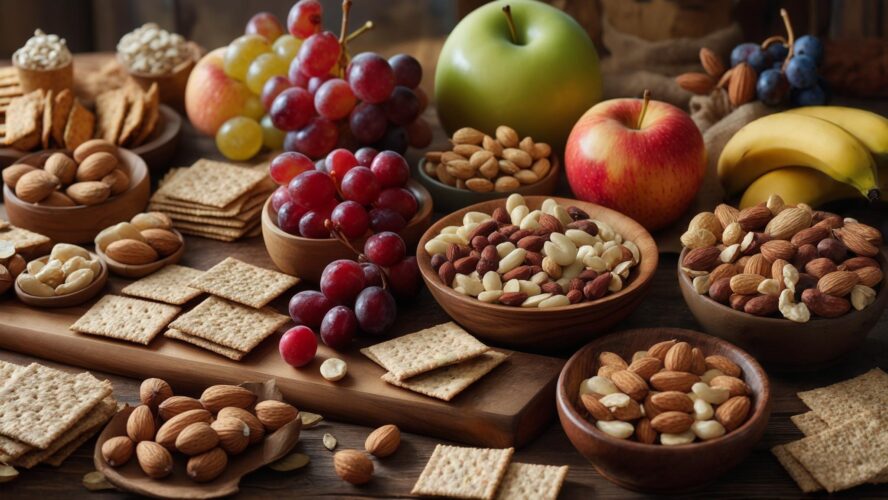
I used to be that person who hit a wall every afternoon around 3 PM. You know the feeling – suddenly your brain feels like it’s running on empty, and you’re desperately searching for something, anything, to get you through the rest of the day. I tried everything from energy drinks to candy bars, but they just left me crashing harder an hour later.
Then I stumbled across some research that totally changed how I think about snacking: high-fiber options. According to Vitafusion research, snack time presents a perfect opportunity to boost your daily fiber intake through delicious, satisfying options. Once I started incorporating these fiber-packed snacks into my daily life, those afternoon crashes became a thing of the past.
This guide shares 25 high-fiber snacks that actually taste good and will keep you energized throughout the day. I’m talking about actual tasty food that hits the spot AND doesn’t leave your stomach feeling weird – no cardboard-tasting “health” bars in sight.
Table of Contents
- What Makes a High-Fiber Snack Worth Your Time?
- Fresh Fruits & Vegetables That Pack a Fiber Punch
- Nuts, Seeds & Dried Fruits for Sustained Energy
- Whole Grain Options That Actually Taste Good
- Legume-Based Snacks for Plant-Powered Nutrition
- Creative Combinations & Smoothies
- How Organic Authority Supports Your Fiber Journey
- Final Thoughts
TL;DR
- High-fiber snacks should contain at least 3-5 grams of fiber per serving, with the best options providing 7+ grams
- Combining fiber with protein and healthy fats maximizes satiety and prevents energy crashes
- Fresh fruits, vegetables, nuts, seeds, whole grains, and legumes offer the most nutrient-dense fiber sources
- Pro tip from someone who learned this lesson the uncomfortable way: ease into the fiber game and drink water like it’s your job
- Batch preparation and choosing portable options makes high-fiber snacking sustainable for busy lifestyles
- Quality ingredients matter – prioritize whole foods over processed options when possible
What Makes a High-Fiber Snack Worth Your Time?
Let me tell you about the Great Fiber Experiment of 2023, when I went overboard and learned the hard way that “more is better” doesn’t apply to everything. Choosing effective high-fiber snacks requires understanding six key criteria that separate truly beneficial options from marketing gimmicks. The best high fiber snacks provide 3-5 grams of fiber minimum (ideally 7+ grams), combine both soluble and insoluble fiber types, offer additional nutrients beyond fiber, accommodate your digestive tolerance, fit your lifestyle needs, and maximize satiety through strategic nutrient combinations.
I’ve learned this the hard way after trying countless “high-fiber” products that left me hungry an hour later or caused uncomfortable digestive issues. The snacks that actually work deliver real health benefits while supporting your daily routine.
For those looking to optimize their digestive health alongside energy levels, understanding 5 simple ways to beat bloat and improve digestion can complement your high-fiber snacking strategy perfectly.
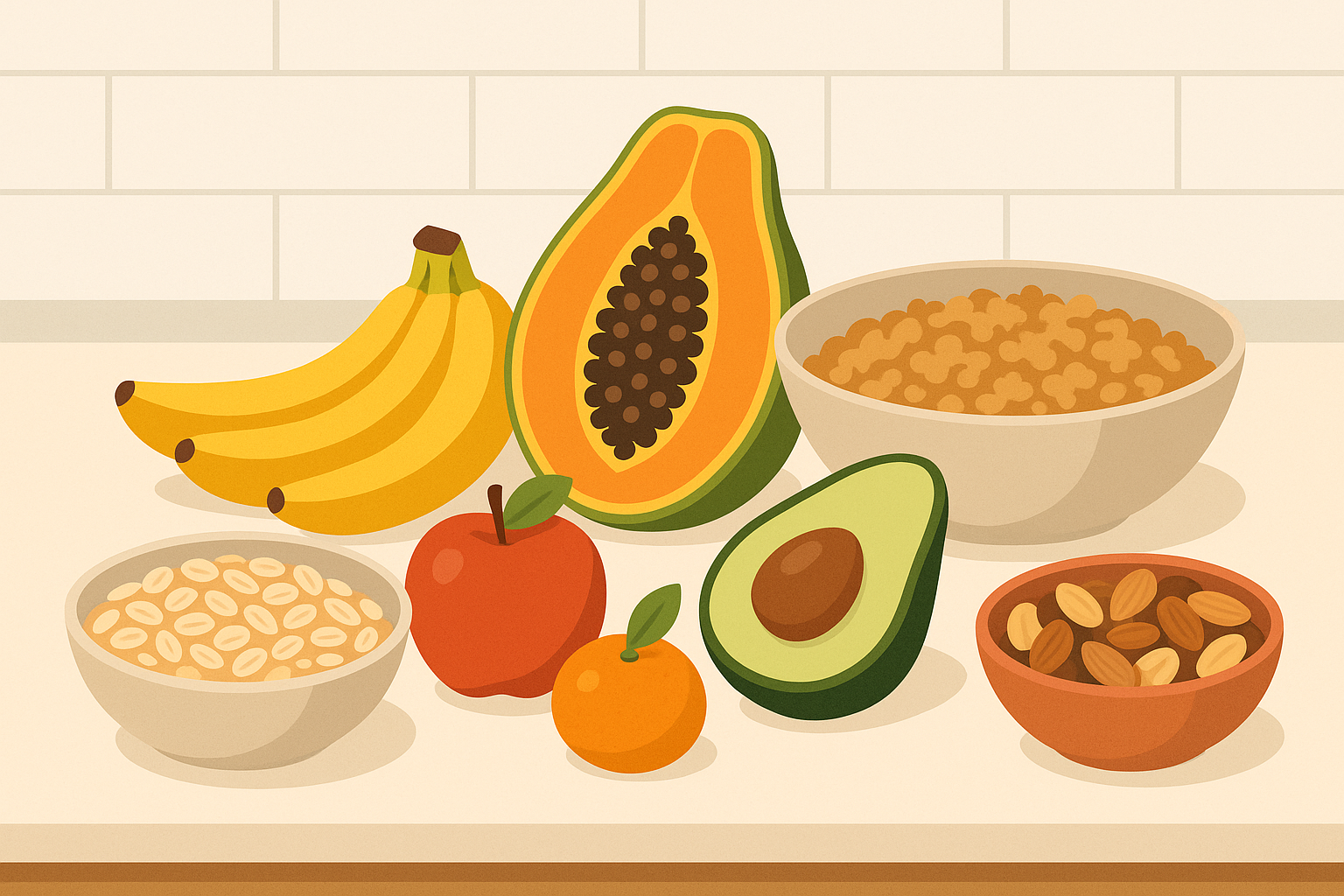
Fiber Content That Actually Matters
Here’s the deal with fiber – there are two types, and you want both. Think of soluble fiber as the stuff that helps your cholesterol and keeps your blood sugar from going crazy, and insoluble as your digestive system’s best friend that keeps things moving along.
The most beneficial high fiber foods combine both types, providing at least 3-5 grams per serving, with premium options delivering 7+ grams for maximum impact. I’ve found that anything less than 3 grams barely makes a dent in my daily fiber goals or my hunger levels.
| Fiber Type | Primary Benefits | Best Food Sources | Daily Target |
|---|---|---|---|
| Soluble | Lowers cholesterol, stabilizes blood sugar, feeds gut bacteria | Oats, beans, apples, berries, chia seeds | 10-15g |
| Insoluble | Promotes regularity, supports digestive health, adds bulk | Whole grains, vegetables, nuts, seeds | 15-20g |
| Total Fiber | Complete digestive support, sustained energy, optimal satiety | Combination of both types | 25-35g |
Beyond Fiber: The Complete Nutritional Picture
I used to be the person buying those expensive “superfood” bars at the checkout counter, convincing myself they were healthy while ignoring the sugar content. High-fiber foods should function as nutritional powerhouses, offering protein, healthy fats, vitamins, and minerals alongside their fiber content. I avoid options loaded with added sugars, excessive sodium, or artificial ingredients that can counteract fiber’s benefits.
The goal is choosing snacks that support overall health while delivering targeted fiber benefits. When I started reading labels more carefully, I was shocked at how many “healthy” snacks were basically candy with a little fiber sprinkled in.
Sarah’s Afternoon Energy Fix: “I used to crash so hard at 3 PM that my coworkers would joke about setting a timer. Now with my apple and almond butter combo, the 7.5 grams of fiber combined with healthy fats keeps me satisfied and energized until dinner. I actually make it to dinner without wanting to nap under my desk, and my afternoon productivity has completely transformed.”
Your Digestive System’s Comfort Zone
Yes, we need to talk about the elephant in the room – fiber and, um, digestive changes. Your body will adjust, I promise. Gradually increasing fiber intake prevents digestive discomfort and allows your system to adapt effectively. Start with smaller portions and maintain adequate hydration, as fiber requires water to function properly in your digestive tract.
Trust me on this one – I made the mistake of going from zero to hero with fiber intake in one day, and my digestive system was not happy about it. Listen to your body’s signals and adjust portions accordingly to find your optimal tolerance level.
When incorporating more fiber into your routine, it’s essential to understand why fiber is so good for your health beyond just digestive benefits.
Fresh Fruits & Vegetables That Pack a Fiber Punch
Fresh produce offers some of the most accessible and nutritious high-fiber snacking options, combining natural sweetness with essential vitamins, minerals, and antioxidants. These foods high in fiber provide excellent digestive tolerance while delivering sustained energy through their natural fiber content.
What I love about fruit and vegetable snacks is their versatility. You can eat them raw, cooked, or combined with other ingredients to create more substantial options. Pairing high fiber fruits and vegetables with protein or healthy fats creates balanced snacks that satisfy hunger for 2-3 hours.
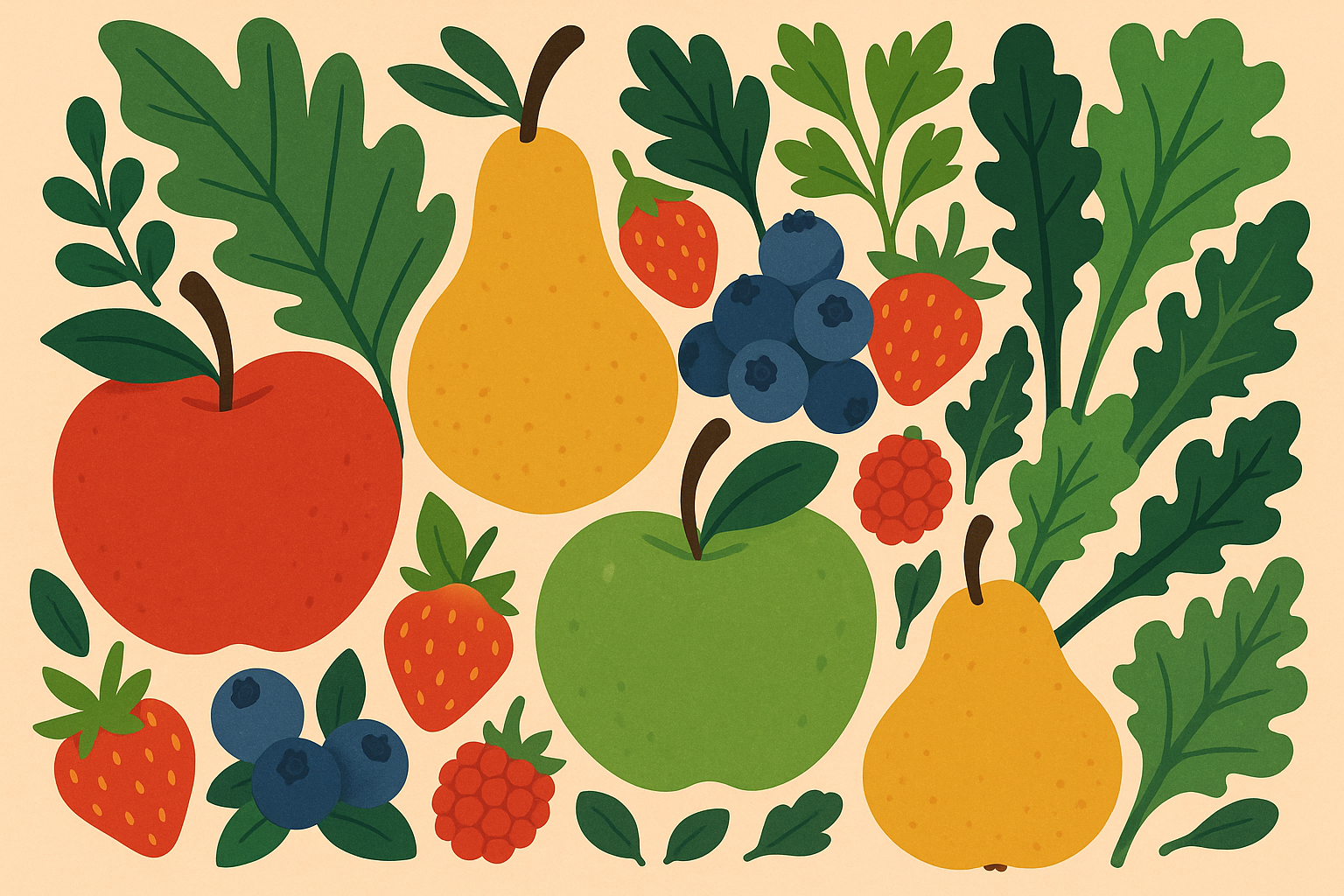
1. Apple Slices with Almond Butter
This classic combination delivers 7.5 grams of fiber by pairing one medium apple with skin alongside 2 tablespoons of natural almond butter. The apple provides 4.5 grams of gentle pectin fiber, while almond butter contributes protein and heart-healthy monounsaturated fats.
I keep pre-sliced apples in lemon water in my fridge and individual almond butter packets in my desk drawer. This snack offers excellent vitamin C and potassium content, requires minimal preparation, and provides sustained energy for 2-3 hours through its balanced macronutrient profile. My coworkers used to tease me about my 3 PM candy bar ritual. Now they’re asking for my apple-and-almond-butter recipe.
2. Pear with String Cheese
One medium pear with skin contains 6 grams of fiber and pairs perfectly with string cheese for protein balance. Rich in vitamin C and folate, this combination provides calcium from the cheese component.
I learned the hard way that “natural” doesn’t always mean “gentle on your stomach” – looking at you, sugar alcohols in those fancy pears. Start with smaller portions if you’re sensitive. This portable snack requires zero preparation and offers good satiety through its fiber-protein combination. I’ve found it’s particularly satisfying when the pear is perfectly ripe – that sweet, juicy texture makes it feel indulgent.
3. Berries and Greek Yogurt Bowl
Mixed berries (raspberries, blackberries, blueberries) combined with plain Greek yogurt create an antioxidant powerhouse delivering 8-10 grams of fiber depending on your berry selection. This combination provides probiotics for gut health alongside high protein content from Greek yogurt.
The probiotics support digestive function while the fiber feeds beneficial gut bacteria, creating excellent digestive tolerance and very high satiety. I buy frozen berries in bulk and thaw them overnight – they’re often more affordable than fresh and just as nutritious.
4. Avocado Toast on Whole Grain Bread
Half an avocado mashed on one slice of whole grain bread (containing at least 3 grams fiber per slice) provides 9-11 grams of total fiber. This combination delivers healthy monounsaturated fats, folate, potassium, and B vitamins.
The healthy fats aid nutrient absorption while providing excellent satiety through the fiber and fat combination. Quick preparation and readily available ingredients make this a convenient choice. For those interested in maximizing the nutritional value of their avocado consumption, explore 5 ways to use an awesome avocado beyond traditional preparations.
5. Carrot and Cucumber Sticks with Hummus
One cup of mixed raw vegetables with ¼ cup hummus provides 6-8 grams of fiber while delivering beta-carotene, vitamin K, and plant-based protein from chickpeas. Raw vegetables may be harder to digest for some people – lightly steaming can improve tolerance.
This snack can be prepped in advance, travels well in containers, and offers moderate satiety through the protein content in hummus. I prep a week’s worth of veggie sticks on Sunday and portion out individual hummus containers for grab-and-go convenience.
Nuts, Seeds & Dried Fruits for Sustained Energy
Nuts, seeds, and dried fruits provide concentrated sources of fiber, healthy fats, and plant-based proteins that deliver exceptional satiety and sustained energy. These high fiber foods offer excellent portability and long shelf life, making them ideal for busy lifestyles.
Their high fat content means smaller portions pack significant nutritional value, while their natural oils support the absorption of fat-soluble vitamins. I always keep a variety of these foods high in fiber in my pantry because they’re perfect for those moments when you need something substantial but don’t have time for meal prep.
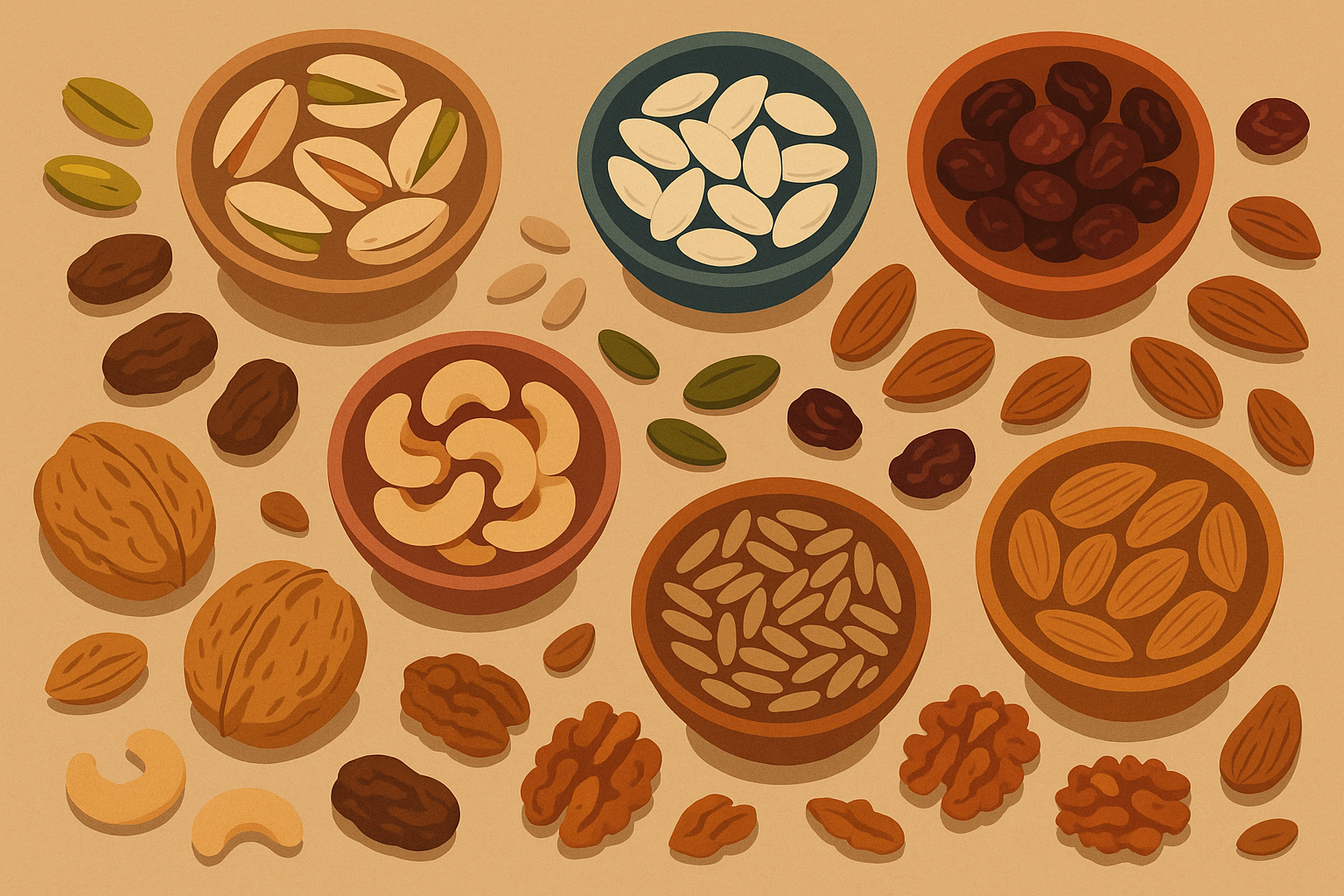
6. Mixed Nuts and Seeds Trail Mix
A ¼ cup mixture of almonds, walnuts, pumpkin seeds, and sunflower seeds provides 4-6 grams of fiber alongside healthy fats, protein, magnesium, and vitamin E. The high fat content requires smaller portions and thorough chewing for optimal digestion.
This extremely portable option offers long shelf life and very high satiety due to its fat and protein content, making it perfect for on-the-go snacking.
Mark’s Travel Solution: “As a consultant who travels frequently, I struggled to find healthy airport snacks that wouldn’t leave me starving or sluggish. I started packing small containers of homemade trail mix with almonds, pumpkin seeds, and a few dried cranberries. The 5 grams of fiber and healthy fats keep me satisfied during long flights, and I avoid the expensive, processed airport options that used to make me feel terrible.”
7. Chia Seed Pudding
Okay, chia seed pudding sounds fancy, but it’s literally just dumping 3 tablespoons of these tiny seeds into a cup of almond milk the night before. Boom – 12 grams of fiber waiting for you in the morning. This superfood snack provides omega-3 fatty acids, calcium, and complete protein.
The first time I tried chia seed pudding, I thought it looked like frog eggs. But desperate times called for desperate measures, and now I’m obsessed. Start with smaller amounts and ensure adequate hydration as chia seeds expand significantly. I make a big batch on Sunday nights and portion it into mason jars for the week.
8. Dried Fruit and Nut Mix
Two tablespoons each of dried apricots, dates, and raw almonds provide 5-7 grams of fiber along with natural sugars, potassium, and healthy fats. The high sugar content may cause bloating in sensitive individuals, so monitor your tolerance.
This shelf-stable and portable option offers good satiety, but watch portions due to calorie density from concentrated natural sugars. I find this combination particularly satisfying when I’m craving something sweet but want to avoid processed candy.
9. Flaxseed Energy Balls
The first time I made energy balls, they looked like something my dog wouldn’t eat. Turns out, presentation doesn’t matter when they taste this good. Homemade energy balls made with ground flaxseed, oats, nut butter, and dates (2-3 balls per serving) deliver 6-8 grams of fiber. These provide omega-3 fatty acids, lignans, and sustained energy from complex carbohydrates.
Ground flaxseed is easier to digest than whole seeds, making this option well-tolerated. Batch prep weekly for convenient grab-and-go snacks with high satiety from the fiber, fat, and protein combination.
10. Pumpkin Seeds (Pepitas)
A ¼ cup serving of roasted, lightly salted pumpkin seeds provides 5 grams of fiber along with zinc, magnesium, and plant-based protein. These seeds are generally well-tolerated when chewed thoroughly and offer ready-to-eat convenience with long shelf life.
Good satiety comes from the protein and healthy fat content, making them an excellent portable snacking option. I buy them in bulk during fall when they They’re cheapest and store them in airtight containers.
Whole Grain Options That Actually Taste Good
I’ll be honest – I used to think “high-fiber” meant “tastes like cardboard.” Boy, was I wrong. Whole grains provide complex carbohydrates and substantial fiber content while offering B vitamins, minerals, and sustained energy release. These foods that are high in fiber support digestive health through their prebiotic fiber content, which feeds beneficial gut bacteria.
When combined with protein or healthy fats, whole grain snacks provide excellent satiety and help maintain stable blood sugar levels throughout the day. I used to think whole grains were boring until I started experimenting with different preparations and flavor combinations.
For those interested in perfecting their oatmeal preparation, learn how to cook delicious oatmeal every time to maximize both flavor and fiber benefits.
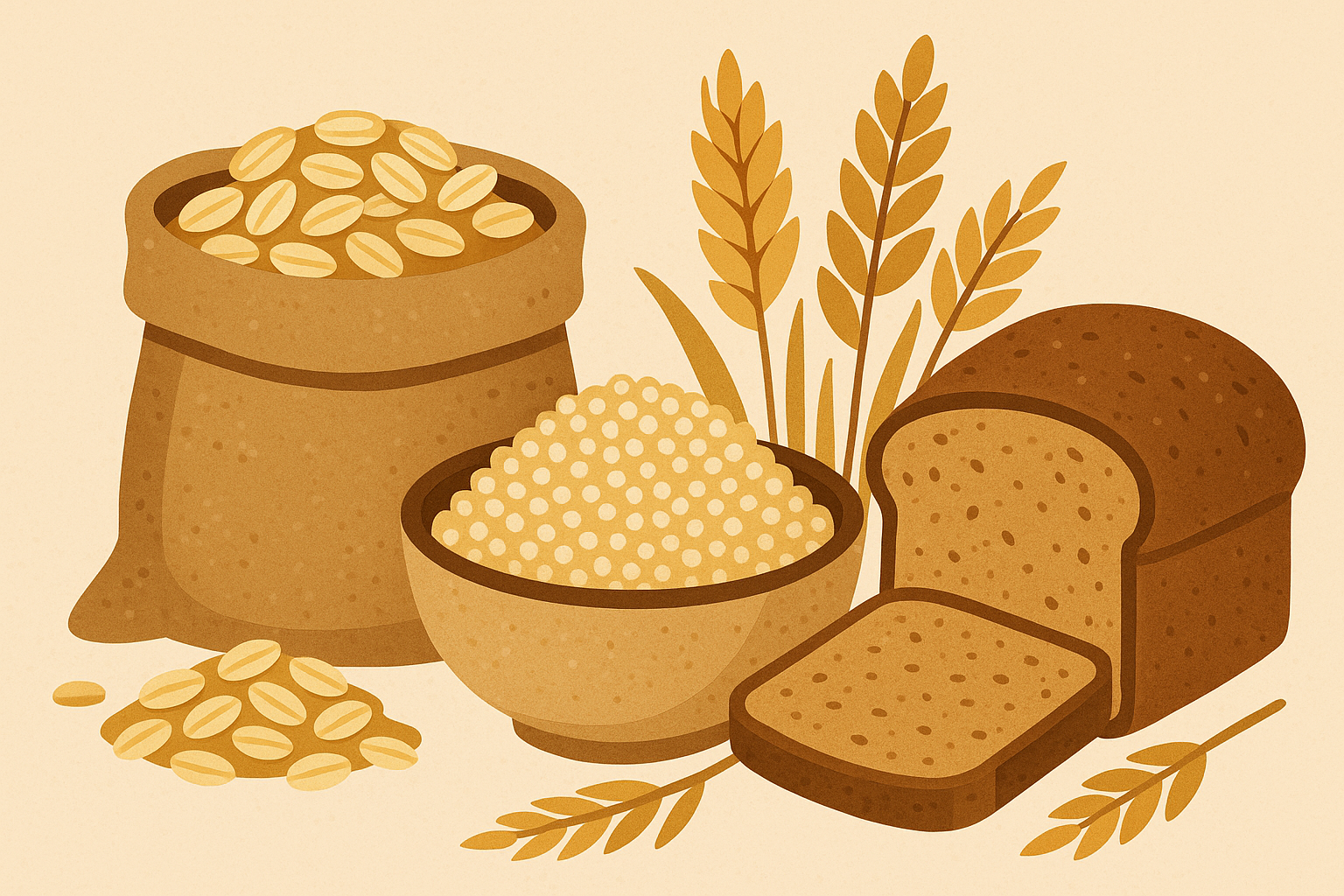
11. Steel-Cut Oatmeal with Berries
Half a cup of cooked steel-cut oats topped with mixed berries provides 8-10 grams of fiber, including heart-healthy beta-glucan fiber. This combination offers B vitamins and antioxidants while supporting gut bacteria through its prebiotic properties.
Excellent digestive tolerance makes this suitable for most people. Batch-cook and reheat for convenience, or try overnight oats versions for very high satiety that keeps you full for hours. I cook a big batch on Sunday and reheat individual portions throughout the week.
| Whole Grain Option | Fiber per Serving | Prep Time | Best Paired With | Satiety Level |
|---|---|---|---|---|
| Steel-Cut Oats | 4g per ½ cup | 20 min (batch cook) | Berries, nuts, seeds | Very High |
| Quinoa | 3g per ½ cup | 15 min | Vegetables, herbs | High |
| Whole Grain Crackers | 3-4g per 6-8 crackers | 2 min | Avocado, hummus | Medium |
12. Whole Grain Crackers with Avocado
When you’re staring at the cracker aisle wondering what the heck “natural flavoring” means, just look for the shortest ingredient list. Your gut will thank you later. Six to eight whole grain crackers (containing 3+ grams fiber) topped with ¼ avocado provide 6-8 grams of total fiber. This combination offers complex carbohydrates and healthy monounsaturated fats for sustained energy.
Choose crackers without excess additives for better digestive tolerance. Quick assembly and good ingredient storage make this convenient, while the fiber and healthy fat balance provides good satiety.
13. Quinoa Salad Cups
Half a cup of cooked quinoa mixed with diced vegetables and herbs delivers 5-7 grams of fiber along with complete protein, iron, and magnesium. Quinoa is generally easier to digest than other grains, making it well-tolerated by most people.
Batch prep multiple servings for convenience, and enjoy high satiety from the protein and fiber combination that makes this a substantial snacking option. I prepare quinoa salad cups with whatever vegetables I have on hand – cherry tomatoes, cucumbers, bell peppers, and fresh herbs work beautifully.
14. Whole Wheat Pita with Hummus and Vegetables
One small whole wheat pita with 3 tablespoons hummus and sliced vegetables provides 7-9 grams of fiber. This combination delivers complex carbohydrates, plant protein, and various vitamins from the vegetable components.
Choose 100% whole wheat options for better digestive tolerance. Easy assembly and good component storage make this convenient, while the fiber-protein combination provides excellent satiety. I stuff mine with whatever crunchy vegetables are in season.
15. Brown Rice Cakes with Almond Butter and Banana
Two brown rice cakes topped with 1 tablespoon almond butter and half a sliced banana provide 5-6 grams of fiber. This combination offers complex carbohydrates, healthy fats, potassium, and natural sugars for sustained energy.
Generally well-tolerated and easy to digest, this snack uses pantry staples for quick assembly and provides good balance for sustained energy through its varied macronutrient profile. The sweetness from the banana makes it feel more indulgent than it actually is.
Legume-Based Snacks for Plant-Powered Nutrition
Legumes offer exceptional fiber density combined with plant-based protein, making them nutritional powerhouses for sustained energy and satiety. These high-fiber foods provide folate, iron, and various minerals while supporting gut health through their prebiotic fiber content.
Cooking legumes thoroughly improves digestibility, and their protein content makes them particularly effective for maintaining stable blood sugar levels and prolonged fullness. I was initially hesitant about legume-based high fiber snacks because of digestive concerns, but proper preparation makes all the difference.
16. Roasted Chickpeas
Roasted chickpeas are basically nature’s version of crunchy snacks, except they actually fill you up. Toss them with whatever spices you’ve got – I’ve tried everything from ranch powder to cinnamon sugar. Half a cup of homemade or store-bought roasted chickpeas with herbs and spices delivers 6-8 grams of fiber alongside plant-based protein, folate, and iron.
May cause gas in sensitive individuals, so start with smaller portions to assess tolerance. Can be batch-made for convenience, offering a crunchy and portable texture. High satiety comes from the protein and fiber content, making this an excellent alternative to processed snack foods.
17. Black Bean and Vegetable Stuffed Mini Peppers
Three to four mini bell peppers stuffed with seasoned black bean mixture provide 8-10 grams of fiber along with antioxidants, folate, and plant-based protein. Cooking beans thoroughly improves digestibility and reduces potential gas production.
Can be prepped ahead and eaten cold or reheated for convenience. Very high satiety due to protein and fiber density makes this a meal-like snacking option. The colorful presentation makes healthy eating feel more exciting.
18. Edamame with Sea Salt
One cup of shelled edamame, lightly steamed and salted, provides 8 grams of fiber along with complete protein, folate, and isoflavones. Generally well-tolerated when cooked, as cooking improves digestibility compared to raw preparations.
Available fresh or frozen for quick preparation convenience. High satiety due to protein content makes this particularly effective for managing hunger between meals. To better understand the complete nutritional profile of edamame, explore the health benefits of edamame and why it’s considered a superfood snack.
19. Lentil Vegetable Soup (Small Bowl)
One cup of homemade lentil soup with mixed vegetables delivers 7-9 grams of fiber plus plant protein, iron, folate, and various vitamins from the vegetable components. Cooked lentils are easier to digest than raw legumes, making this well-tolerated by most people.
Batch cook and freeze portions for convenience, and the thermos-friendly nature makes it portable. Very high satiety comes from both fiber content and liquid volume.
Jessica’s Meal Prep Success: “Sunday meal prep used to feel overwhelming until I discovered batch-cooking lentil soup. I make a huge pot with carrots, celery, and spinach, then freeze individual portions in mason jars. When I need a satisfying snack that won’t spoil my dinner appetite, I just microwave a cup – the 8 grams of fiber and plant protein keep me perfectly satisfied for hours, and it feels like I’m treating myself to restaurant-quality nutrition.”
20. White Bean and Herb Dip with Vegetables
A ¼ cup serving of white bean dip with 1 cup raw vegetables for dipping provides 8-10 grams of fiber along with plant protein, potassium, and various vitamins from the vegetable selection. Pureed beans are generally easier to digest than whole bean preparations.
The dip can be made ahead while vegetables can be prepped in advance for convenience. Good balance of fiber and protein provides sustained satiety. I blend white beans with garlic, lemon juice, and fresh herbs for a creamy, satisfying dip.
Creative Combinations & Smoothies
If you’re like me and meal prep makes you want to hide under a blanket, these grab-and-go options are about to become your new best friends. Creative fiber combinations and smoothies offer versatility and convenience while maximizing nutrient density through strategic ingredient pairing. These options allow for customization based on taste preferences and dietary needs while maintaining high fiber content.
Blending and creative preparation methods can improve digestibility while creating satisfying textures that make healthy eating more enjoyable. These foods high in fiber combinations have become my go-to when I want something that feels special but still supports my health goals.
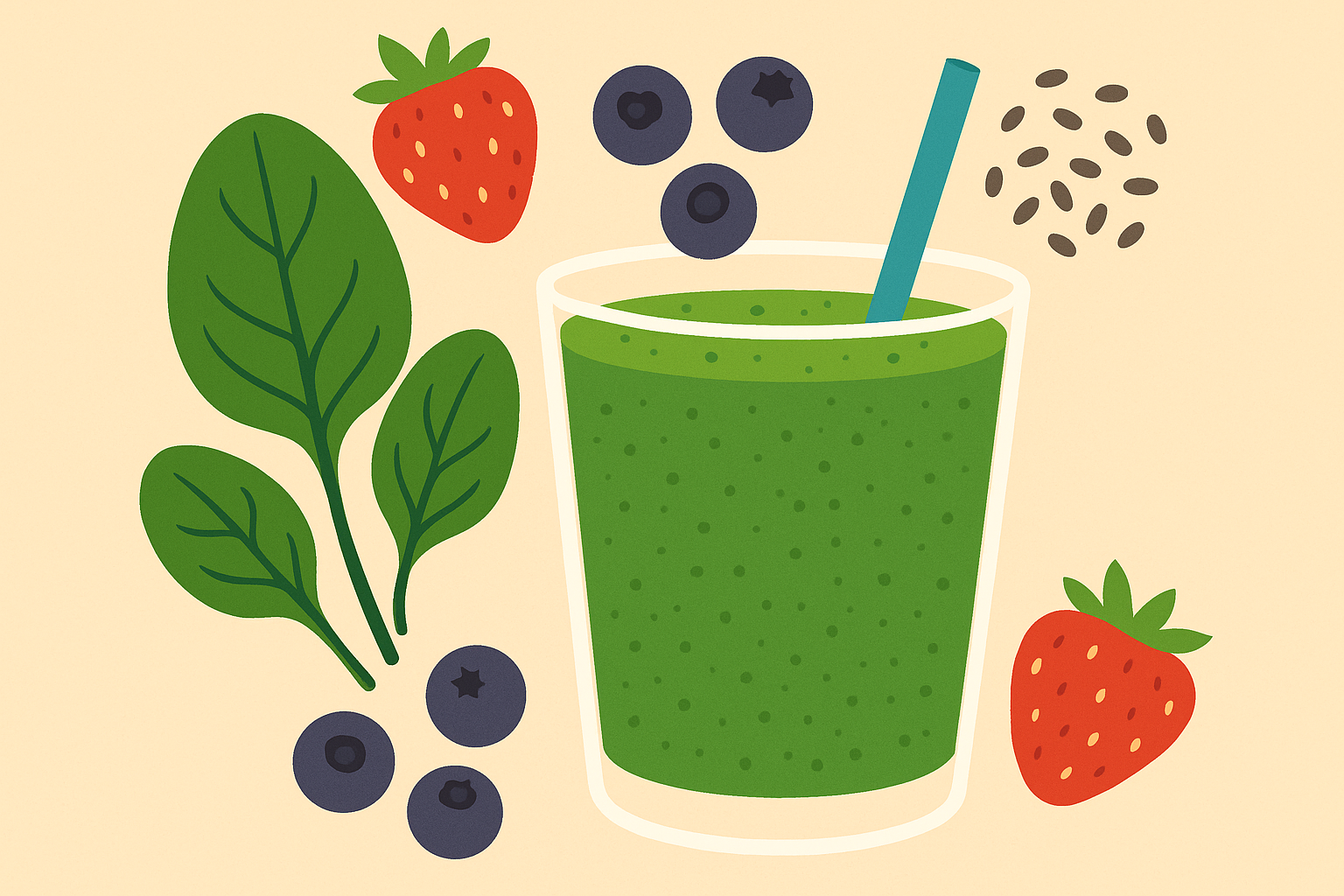
21. Green Smoothie with Spinach and Fruit
Two cups spinach, 1 banana, ½ cup berries, 1 tablespoon ground flaxseed, and plant milk create a smoothie with 10-12 grams of fiber. This powerhouse provides iron, folate, potassium, omega-3s, and antioxidants in one convenient serving.
Blending breaks down fiber for easier digestion while maintaining nutritional benefits. Quick preparation and freezer pack prep options make this convenient, with high satiety when including protein powder or nut butter. The fruit completely masks the spinach taste – even my veggie-averse friends are surprised.
22. Sweet Potato and Black Bean Mini Muffins
Two homemade mini muffins made with sweet potato puree and black bean flour provide 6-8 grams of fiber along with beta-carotene, complex carbohydrates, and plant protein. Sweet potato is gentle on digestion, making this well-tolerated by most people.
Batch bake and freeze for grab-and-go convenience. Good satiety comes from the fiber and complex carbohydrate combination that provides sustained energy release.
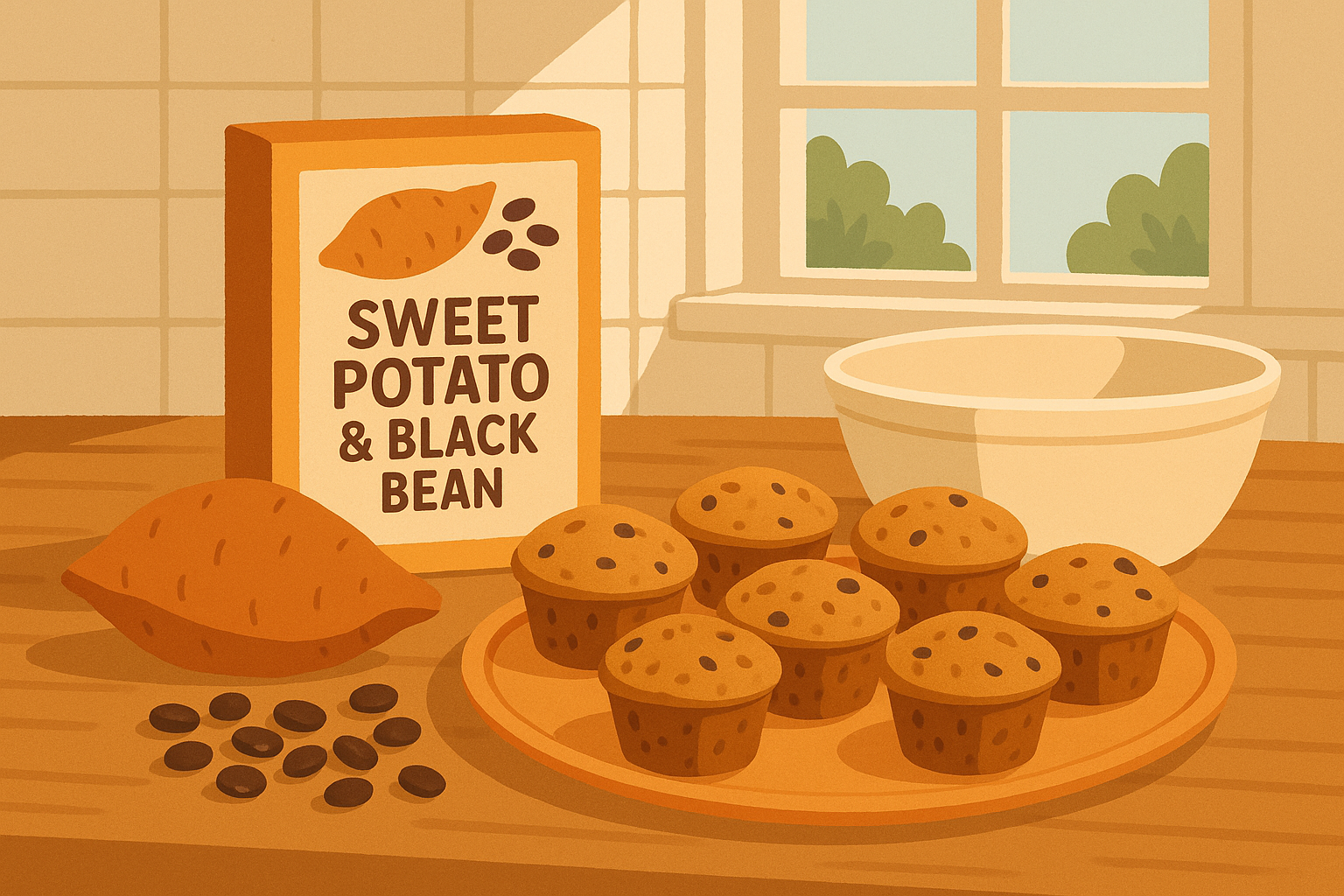
23. Chia Seed Jam on Whole Grain Toast
Two tablespoons of homemade chia jam (chia seeds plus mashed berries) on one slice of whole grain bread delivers 8-10 grams of fiber. This combination provides omega-3 fatty acids, antioxidants, and B vitamins in a satisfying format.
Chia seeds expand significantly, so drink plenty of water with this snack. Chia jam keeps for weeks, making assembly quick and convenient, while high satiety comes from fiber expansion and healthy fats. Making your own jam means controlling the sweetness level perfectly.
24. Stuffed Dates with Nuts and Seeds
Three to four Medjool dates stuffed with almond butter and topped with hemp seeds provide 6-8 grams of fiber along with natural sugars, healthy fats, and complete protein from hemp. Natural sugars provide quick energy while fiber slows absorption for sustained release.
Can be prepped ahead and naturally portable for convenience. Good satiety, but portion control is important due to calorie density from natural sugars. These taste so decadent that guests never believe they’re actually healthy.
25. Vegetable and Hummus Wrap
A large whole wheat tortilla with 3 tablespoons hummus and 1 cup mixed raw vegetables provides 10-12 grams of fiber along with plant protein, various vitamins, and complex carbohydrates. Raw vegetables may be challenging for some – lightly steaming helps improve digestibility.
Portable and filling nature makes this convenient for meal-like snacking, while very high satiety comes from size and fiber-protein combination. I roll mine tightly and slice into pinwheels for easier eating.
For optimal digestive comfort when incorporating these high-fiber options, consider implementing strategies from why dietary fiber is the real macronutrient you need to watch to maximize benefits.
| Snack Category | Average Fiber (g) | Prep Time | Portability | Best For |
|---|---|---|---|---|
| Fresh Fruits & Vegetables | 6-10g | 2-5 min | Medium | Quick energy, vitamins |
| Nuts & Seeds | 4-12g | 1-15 min | High | Sustained energy, travel |
| Whole Grains | 5-10g | 3-20 min | Medium | Long-lasting fullness |
| Legumes | 6-10g | 5-30 min | Medium | Protein + fiber combo |
| Creative Combinations | 6-12g | 5-15 min | High | Customizable nutrition |
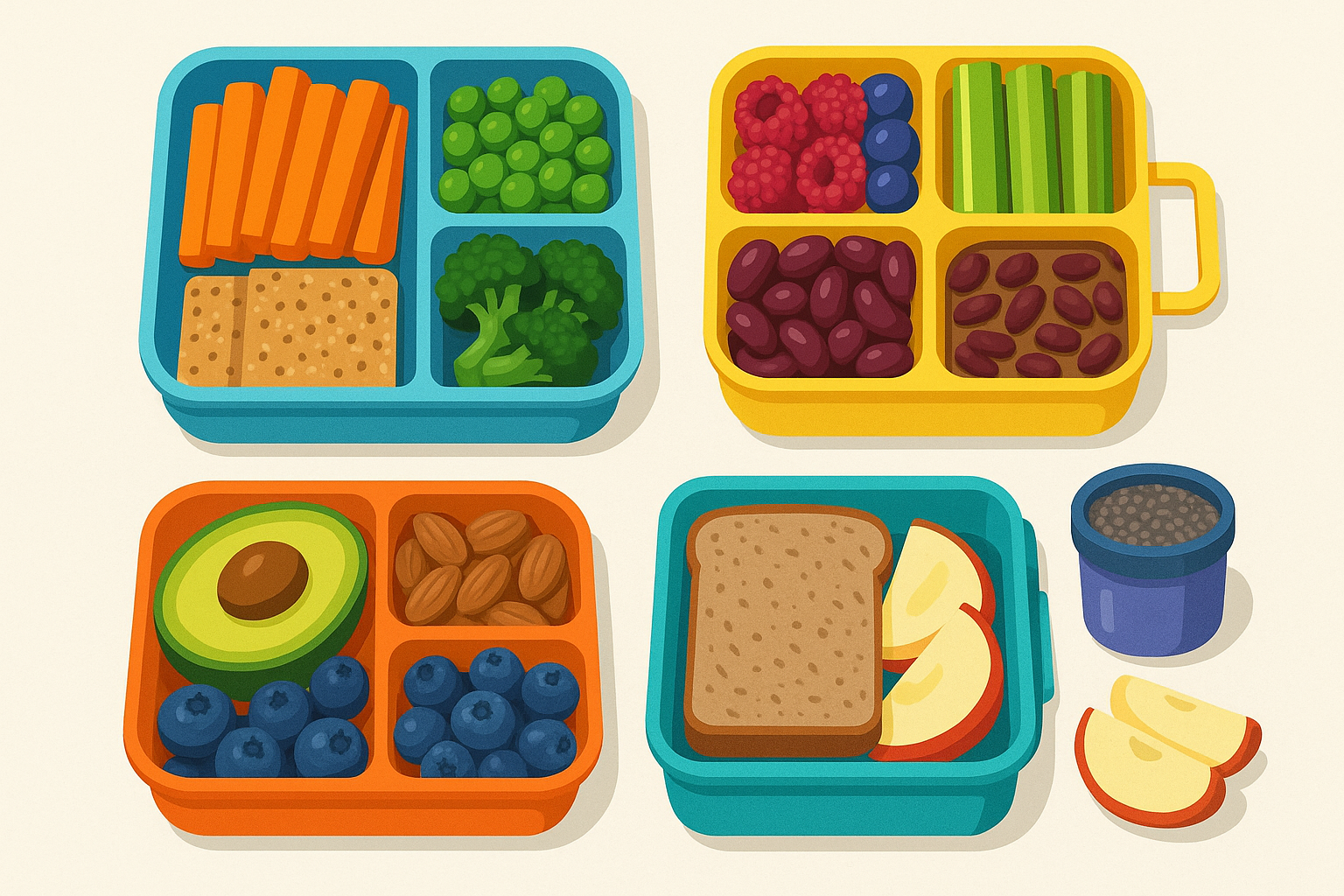
How Organic Authority Supports Your Fiber Journey
Here’s the thing – we get that eating well shouldn’t feel like a part-time job. That’s why we’ve done the homework on finding stuff that’s actually clean and won’t break the bank. At Organic Authority, we understand that building sustainable wellness habits requires access to high-quality, transparently sourced ingredients that align with your health goals. Our carefully curated selection of organic, clean-label products supports your high-fiber snacking journey by providing the premium nuts, seeds, grains, and superfoods you need to create these nutritious options.
We’ve done the research to ensure every product meets our strict standards for purity, sustainability, and nutritional value, so you can focus on enjoying your fiber-rich snacks with confidence. Ready to upgrade your snacking game? Explore our collection of organic pantry essentials and discover how clean eating can transform your energy levels naturally.
For those seeking comprehensive nutrition guidance beyond fiber, explore our insights on 3 dietary supplements you should take daily to complement your whole food approach.
Final Thoughts
Listen, you don’t have to become a fiber fanatic overnight. Pick two or three of these that sound doable, give them a shot, and see how you feel. Your future 3 PM self will probably send you a thank-you note. Building a sustainable high-fiber snacking routine doesn’t require perfection – it requires consistency and smart choices that work with your lifestyle. These 25 options give you the flexibility to experiment and find combinations that satisfy your taste preferences while supporting your digestive health and energy levels.
Remember to increase your fiber intake gradually, stay hydrated, and listen to your body’s signals as you incorporate these high fiber snacks into your routine. Start with 2-3 options that appeal to you most, then expand your repertoire as your digestive system adapts and you discover new favorites.
The key to long-term success lies in choosing whole food sources that provide multiple nutrients beyond just fiber. When you prioritize quality ingredients and balanced combinations, you’re fueling your body with the clean nutrition it needs to thrive throughout your busy days. These high-fiber foods have transformed how I approach snacking, and I’m confident they’ll do the same for you.

